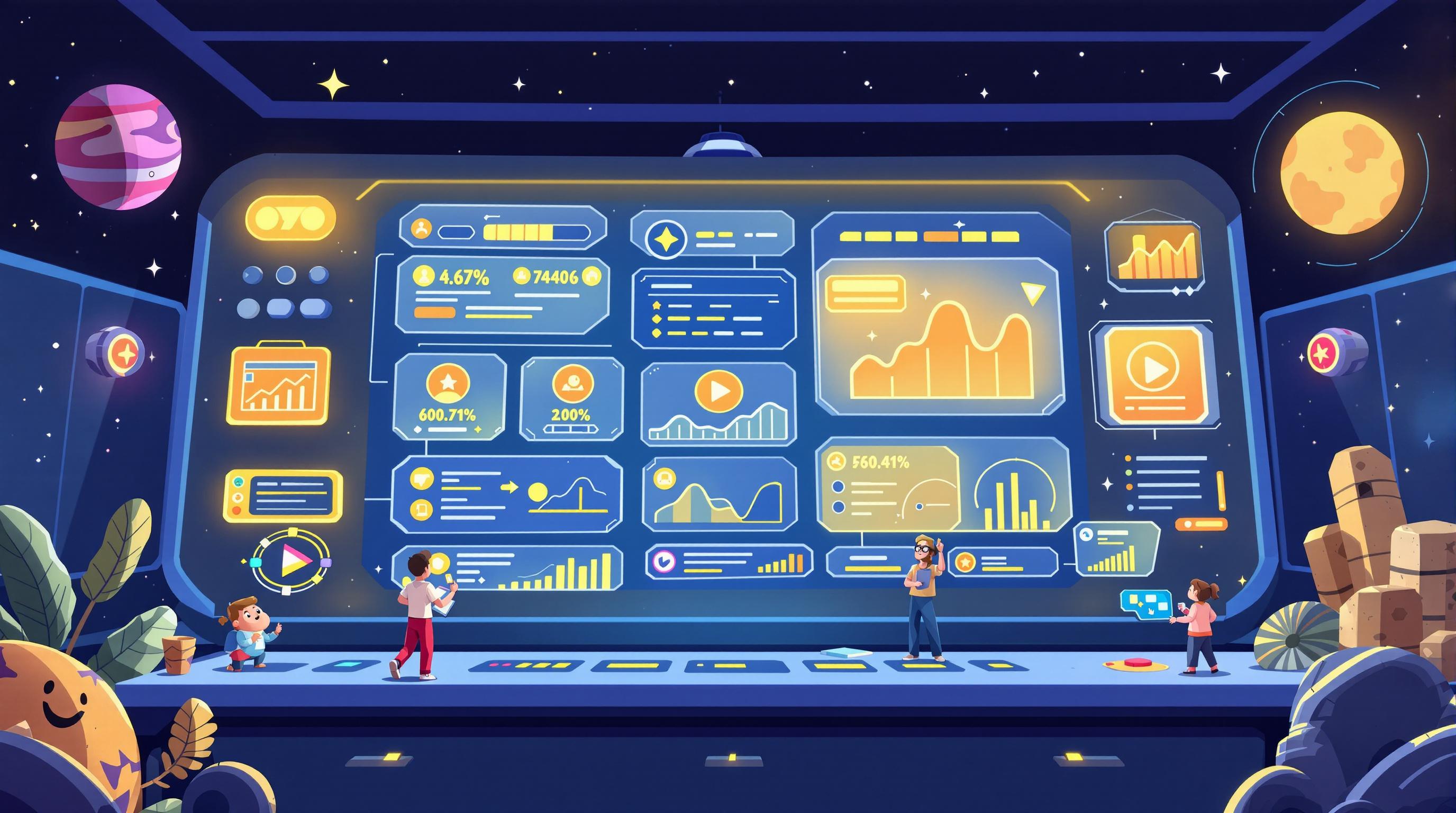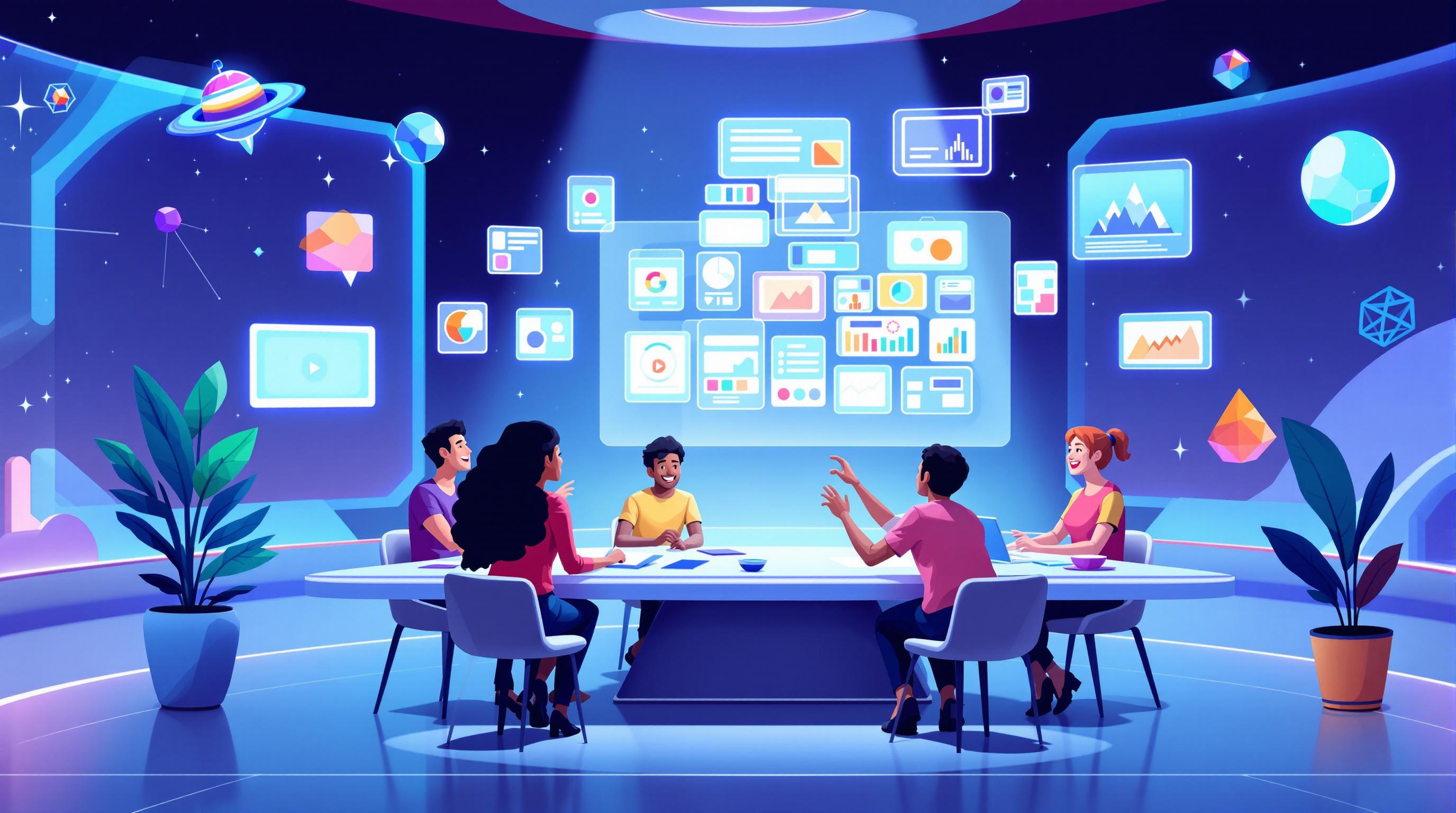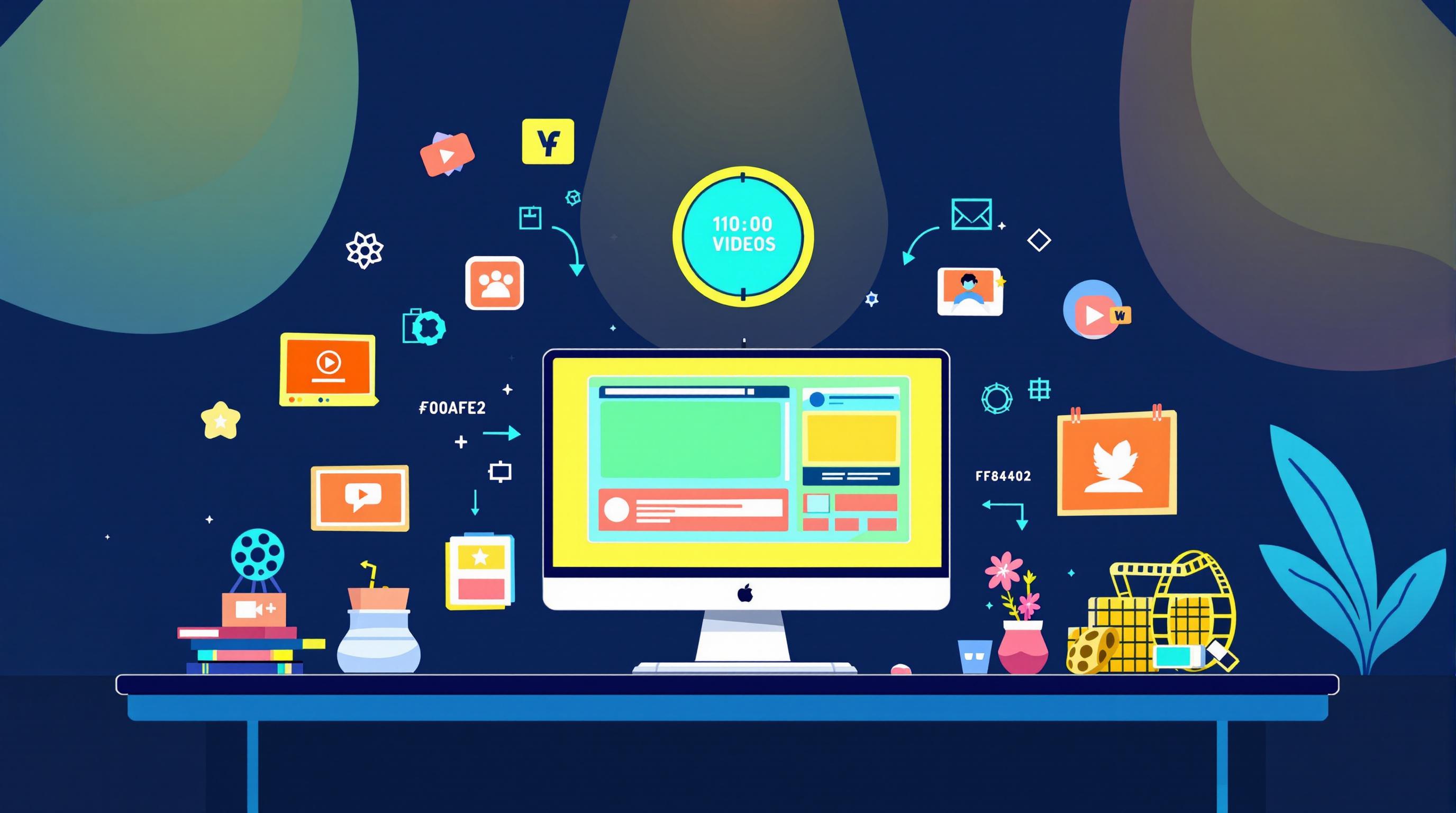AI video production is faster and cheaper, while traditional methods offer higher quality and creative control. Here's a quick breakdown to help you choose:
Key Points:
- Cost: AI tools cost $18-$89/month, while traditional production costs $800-$10,000 per minute.
- Time: AI can cut production time by up to 80%, delivering videos in hours or days. Traditional methods take weeks or months.
- Workflow: AI simplifies processes with templates and automation. Traditional production involves multiple professionals, offering more customization.
- Best For:
- AI: Social media, training videos, and high-volume projects.
- Traditional: Complex storytelling, cinematic visuals, and premium branding.
Quick Comparison Table:
| Feature | AI Video Production | Traditional Video Production |
|---|---|---|
| Cost | $18-$89/month | $800-$10,000/minute |
| Time | Hours to days | Weeks to months |
| Creative Control | Limited | High |
| Best Use Cases | Quick, scalable content | High-quality, custom projects |
Bottom Line: Use AI for speed and budget efficiency. Choose traditional methods for complex, high-end visuals. A hybrid approach often works best.
Main Differences Between AI and Traditional Video Production
Cost Breakdown
Traditional video production comes with hefty price tags due to the need for equipment, a professional crew, and studio rentals. On average, costs range from $800 to $10,000 per minute. These expenses can climb further with additional shooting days, talent fees, and post-production work.
AI-powered tools, however, offer a more budget-friendly and predictable pricing model. Platforms like Paracast.io provide subscription plans starting at $20 per month, allowing users to generate videos efficiently. Similarly, Crayo.ai offers plans starting at $19 per month, which includes up to 40 minutes of video export.
| Production Type | Initial Costs | Ongoing Costs | Additional Expenses |
|---|---|---|---|
| Traditional | $800-10,000/minute | Equipment maintenance | Crew, talent, studio rentals |
| AI-Based | $19-89/month | Subscription fees | Optional asset purchases |
Time Comparison
Time is another area where these two approaches differ dramatically. Traditional video production typically spans weeks or even months, covering stages like pre-production planning, shooting schedules, and post-production editing [3].
AI tools can slash these timelines down to just hours or even minutes. For example, Synthego reported a 39% reduction in production hours by using AI tools [2]. Automated features like scene adjustments and color correction speed up the process, making AI a game-changer for fast-paced projects.
Workflow Comparison
The workflow for traditional video production is complex and involves multiple stages. From scriptwriting to final delivery, each step requires coordination among various teams and specialists. This method is ideal for projects that demand a high level of creativity and customization.
AI tools simplify this process significantly. Platforms like Synthesia use pre-designed templates, allowing users to create videos by simply adding their content. This makes AI tools especially useful for marketers or businesses looking for quick, consistent outputs.
While traditional methods emphasize creative flexibility and emotional depth, AI tools prioritize speed and uniformity. AI is excellent for projects with tight deadlines and standardized formats, but traditional production is still the go-to for intricate, highly customized work that may involve special effects or deeper storytelling [3].
Both methods have their strengths, and choosing the right one depends on your project's specific needs and goals.
Strengths and Weaknesses of Traditional Video Production
Benefits of Traditional Video Production
Traditional video production stands out for its ability to deliver high-quality visuals with full creative control. Teams can meticulously adjust every aspect, from lighting to sound, ensuring the final product matches the exact vision. This level of precision is especially important for projects that demand detailed storytelling.
Another advantage is the capability to craft intricate narratives. With access to professional-grade equipment and experienced crews, companies can achieve a cinematic feel that’s hard to match with automated tools. Plus, real-time adjustments can be made during filming, allowing for on-the-spot tweaks to enhance the outcome.
Challenges of Traditional Video Production
One of the biggest obstacles is the hefty financial commitment. Traditional production can be expensive, particularly for complex projects. Additional costs, like stock footage priced between $100-$250 per clip, can quickly add up [3].
Time is another challenge. The process involves multiple stages, each requiring careful planning and collaboration across a team of professionals. While skilled crews deliver exceptional results, assembling and managing these experts can be difficult, especially for startups or small teams with limited budgets.
Although traditional methods excel in delivering quality and creative flexibility, their high costs and slower timelines have opened the door for AI-driven solutions.
Summary Table of Pros and Cons
| Advantages | Disadvantages |
|---|---|
| Exceptional visual quality | High production costs |
| Full creative control | Lengthy production timelines |
| Ability to tell complex stories | Requires specialized equipment |
| Professional-grade effects | Relies on skilled professionals |
| Real-time shooting adjustments | Coordination can be challenging |
| Maintains brand consistency | Less adaptable to quick changes |
| Customized solutions | Demands significant resources |
Strengths and Weaknesses of AI Video Production
Benefits of AI Video Production
AI video production has transformed how content is created, especially when it comes to saving time. Research shows that AI tools can cut project timelines by 62% - reducing the average production time for marketing videos from 13 days to just 5 days [4]. This speed allows teams to produce promotional content much faster without compromising on quality.
Another major advantage is affordability. With subscription plans ranging between $20 and $80 per month, even small businesses and startups can create professional-grade videos. This pricing model levels the playing field, giving smaller teams access to tools that were once reserved for larger organizations.
AI tools are also great for producing content at scale. They enable businesses to create hundreds of videos quickly while ensuring that branding stays consistent across all outputs. This makes them ideal for high-volume projects where efficiency and uniformity are key. However, while AI excels in speed and scalability, it does have some drawbacks that can impact certain creative projects.
Challenges of AI Video Production
AI video production isn’t without its challenges, especially when it comes to creativity. Although many platforms offer extensive libraries of templates, they often fall short when nuanced storytelling or artistic direction is required - areas where human expertise still shines.
Quality can also be a concern. While AI tools can produce high-definition videos (1080p), they may struggle with more complex narratives or projects that demand emotional depth. For example, 43% of organizations have started using AI tools to replace traditional video workflows [4], but many still rely on a hybrid approach for projects requiring a more artistic touch.
Technical limitations are another hurdle. Many AI platforms impose usage caps, which can be a problem for projects that need extensive customization or longer video durations. These restrictions can limit the flexibility of AI tools for larger, more intricate productions.
Summary Table of Pros and Cons
| Advantages | Disadvantages |
|---|---|
| Cuts production time by up to 80% | Limited creative flexibility |
| Budget-friendly subscription pricing | Template-dependent designs |
| Ideal for high-volume production | Usage caps on many platforms |
| Ensures consistent branding | Lacks emotional storytelling depth |
| No extra equipment required | Struggles with complex narratives |
| Quick updates and revisions | Quality may vary across outputs |
| Easy to use with minimal expertise | Platform-specific constraints |
sbb-itb-5bfa442
Choosing the Right Method for Your Project
When to Choose Traditional Video Production
Traditional video production is the go-to option for projects that require detailed storytelling or a cinematic feel. Think about luxury car commercials or movie trailers - these types of content demand a level of visual complexity and emotional depth that AI tools can't fully achieve yet. If your project needs to highlight intricate product details or create a powerful emotional connection, traditional methods give you the creative control to make it happen.
While traditional production offers unmatched creative depth, it's worth noting that AI brings speed and efficiency to the table for more routine content.
When AI Video Production Works Best
AI video production is perfect for projects where speed and budget are key factors. It's especially useful for tight deadlines, frequent updates, or when you need a high volume of content. Take Synthego's World CRISPR Day animated video campaign as an example - they used AI to streamline production and saw impressive results [2].
Here are some areas where AI tools excel:
- Social media content that needs regular updates
- Product demo videos
- Training and onboarding materials
- Variations for marketing campaigns
AI helps deliver consistent branding while allowing for quick content creation and updates.
Blending AI and Traditional Techniques
In many cases, a hybrid approach works best. AI can handle repetitive tasks like storyboarding, basic editing, or quick revisions, while traditional production focuses on creative elements like custom animations and core branding messages.
This mix lets companies work efficiently without sacrificing quality. For example, teams might use AI for template-based videos or fast-turnaround projects, reserving traditional methods for high-impact content that requires a personalized touch.
Generative AI vs AI Video Generators: Best Tools, Pricing & Top Picks
Conclusion: Deciding Between AI and Traditional Video Production
Choosing between AI and traditional video production comes down to your project's needs. It's about finding the right balance between cost, time, and quality. Traditional methods deliver top-tier quality but often require a larger budget and more time. On the other hand, AI tools are faster and more affordable.
Here’s a quick guide to help you decide:
| Production Need | Recommended Approach | Key Consideration |
|---|---|---|
| High-volume content | AI Production | Cost-effective and scalable |
| Premium branding | Traditional | Greater control over quality |
| Quick turnaround | AI Production | Speed: minutes vs. weeks |
| Complex storytelling | Traditional | More creative flexibility |
| Regular updates | AI Production | Easy and efficient updates |
A hybrid approach might be the best of both worlds. Use AI for repetitive, time-sensitive tasks and traditional production for projects that demand a polished, creative touch. This way, you can maximize efficiency without compromising on quality.
For teams that need a steady stream of content, AI tools are a practical option. Many platforms offer customizable templates and branding features, making it easier for businesses of any size to create professional videos. The key is aligning your choice with your project's goals, timeline, and budget.
Video production is constantly evolving. AI tools are becoming more efficient, while traditional methods continue to set the bar for quality. Whether you're working on product demos, feature launches, or social media clips, combining the strengths of both approaches can help you meet a variety of content needs effectively.
FAQs
This section answers common questions about the costs of AI and traditional video production, helping you choose the best option for your budget and project goals.
How much do AI videos cost?
AI video production platforms can be a budget-friendly choice for businesses of all sizes. For example, Superside created 450 personalized videos in just one week, cutting design hours by 39% and saving $5,000 in costs [2].
While AI is a cost-efficient option for many, traditional video production has its own pricing structure that reflects the resources and expertise involved.
How much do video production companies charge?
| Service Component | Includes |
|---|---|
| Equipment | High-end cameras, lighting, and sound equipment |
| Labor | Production crew, directors, and technical staff |
| Post-Production | Editing, color work, sound mixing, and effects |
For projects involving advanced effects or well-known talent, costs can reach up to $10,000 per minute [1].
Choosing the best option depends on your needs. AI tools are great for frequent content updates or large-scale production. On the other hand, traditional production is often worth the investment for high-end branding or intricate storytelling.


